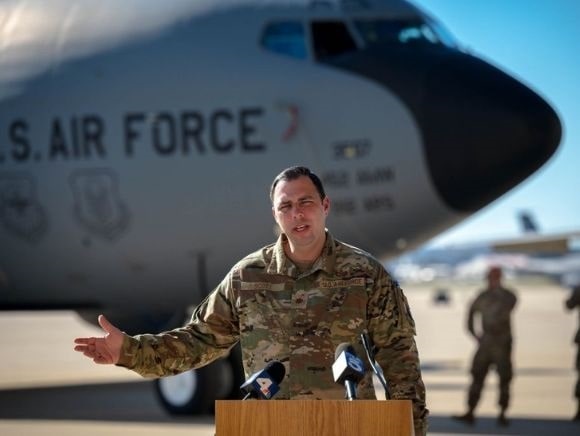During budget deliberations, Congress and the US Air Force plan to cut aerial tanker capability in the FY2023 National Defense Authorization Bill. But the Air Force is overlooking a rule in fighting wars. If you are going to fight an enemy, you must go where the enemy is. Throughout the history of warfare – Peloponnesian Wars, Romans engaging Gaul, the minutemen beating back the British during the Revolutionary War, you name it – getting to the fight was important. So why does the US Air Force want to reduce its aerial tanker fleet and, with that move, reduce the capability to move fighters, bombers, and other tankers to where needed?
The current airborne tanker fleet of KC-135 Stratotankers, re-engined and upgraded 1950s vintage military versions of the Boeing 707 aircraft, KC-10 Extenders, and the newest aerial tanker, the KC-46 Pegasus, perform the airborne tanker mission. The strategic tasks these tankers must perform in wartime and during contingencies are three-fold: providing enroute fueling during fighter, bomber, and air cargo aircraft like the C-17s used in the Afghanistan airlift of refugees; combat air refueling close to the battle to keep fighters and bombers in the fight; and, as a complementary capability, the air refueling aircraft can carry pallets of cargo.
Air refueling the long-range cargo aircraft like C-5 Galaxies and C-17 Globemasters establishes the lifeline for deployments to the conflict. C-17s have the added advantage of being refueled in the air, flying long distances, and landing on short runways closer to the battle area. So, cutting the number of tankers and reducing the capability to keep the warfighters supplied and in the air endangers overall US mobility to get to the enemy where it is.
For some time, the Air Force has been reducing the number of KC-135s and KC-10s with the hope of stabilizing the overall tanker capability by bringing on 179 of the newer KC-46s, of which 56 had been built as of November 2021. In FY2019, Congress established the number of refueling aircraft the Air Force would have in its inventory. “Congress set that 479 requirement when it passed the [FY]2019 National Defense Authorization Act, which was based on a TRANSCOM [US Transportation Command] study from 2018 that found that number to be the minimum fleet size required if war broke out,” Stephen Losey writing for Defense New explained recently.
The study referred to was the Mobility Capabilities and Requirements Study (MCRS) 2018, which sized the refueling fleet at 479 as a minimum “consistent with the NDS [National Defense Strategy] wartime missions in 2023, and available, approved demands.” The study methodology “focused significantly on identifying mobility impacts in contested environments based on credible threat estimates” and determined 479 was the minimum acceptable to address the threat.
Now Congress and the Air Force are telling the American taxpayer the actual number of tanker aircraft is 455, or 24 fewer than the FY2019 NDAA mandate of 479 and 28 fewer than in the FY2023 President’s Budget Request. “Air Force Secretary Frank Kendall said at a Heritage Foundation event the service would ask Congress to lower its tanker requirement to 455, which he said would be ‘adequate’ to respond to a threat from China as well as other missions,” Losey said. So what’s wrong with this picture? First, either the requirement is based on a threat, or it is not. One does not arbitrarily “lower” the requirement. Kendall didn’t suggest a lower threat in March of this year.

Secretary Frank Kendall (Tom Williams/CQ-Roll Call, Inc via Getty Images)
“But China, with both regional and global ambitions, the resources to pursue them, and a repressive authoritarian system of government, will be our greatest strategic national security challenge. Some of you will recall my three priorities from last September when I spoke at that AFA conference – China, China, China,” Kendall told an Air Force Association Warfare Symposium a little over two months ago. Well, China is a long way to deploy forces to meet the Chinese Communist Party’s (CCP) challenge, and you don’t get there by slashing the capability to move the forces to meet the challenge. Furthermore, there is absolutely no analysis backing up the number 455. But as Kendall said at the conference, he focused funding more on modernization. The 455 number is a “budget convenience” to satisfy putting money in new fighters like the Next Generation Air Dominance (NGAD) fighter Kendall considers an “imperative.”
Others see the need to get to the fight more realistically. “As the US military adopts new concepts to enhance its lethality and gain decision advantage, aerial refueling is increasingly necessary to enable a more distributed and dynamic force,” the Hudson Institute’s Timothy Walton and Bryan Clark concluded in their comprehensive study “Resilient Aerial Refueling: Safeguarding the US Military’s Global Reach.” Walton and Clark recommend enhancing US airborne refueling capability with new tankers, not reducing it.
Few deny more lethal capability and advanced Air Force combat systems like NGAD are needed to meet and defeat an enemy like the People’s Republic of China. But, unless the Air Force plans to fight the CCP in the sky over Miami, reducing the capability to get to the fight is not the answer.
The views expressed are those of the author and not of any other affiliation.




